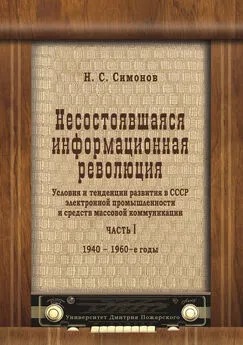Ричард Харрис - Психология массовых коммуникаций
- Название:Психология массовых коммуникаций
- Автор:
- Жанр:
- Издательство:2002
- Год:2002
- Город:Санкт-Петербург
- ISBN:5-93878-033-0
- Рейтинг:
- Избранное:Добавить в избранное
-
Отзывы:
-
Ваша оценка:
Ричард Харрис - Психология массовых коммуникаций краткое содержание
«Предупреждён – значит вооружён». Такой эпиграф мог бы открывать эту книгу. И не имеет значения, кто возьмёт её в руки. Специалист почерпнёт в ней новые приёмы и подходы к анализу стратегии и тактики СМИ. Любознательный обыватель научится обеспечивать собственную информационную безопасность.
Кроме того картина информационного ландшафта современного общества от предвыборного управления массовым сознанием до рекламы памперсов оказывается настолько захватывающей, что однажды начав читать эту книгу, вы уже не оставите её недочитанной.
Психология массовых коммуникаций - читать онлайн бесплатно полную версию (весь текст целиком)
Интервал:
Закладка:
Dorr, A., Graves, S. В ., Phelps, E. (1980). Television literacy for young children. Journal of Communication, 30, 71–83.
Dorr, A., Kovaric, P (1980). Some of the people some of the timebut which people? Televised violence and its effects. In: E. Palmer A. Dorr (Eds.). Children and the faces of television (p. 183–199). New York: Academic Press.
Dorr, A., Kunkel, D. (1990). Children and the media environment: Change and constancy amid change. Communication Research, 17, 5–25.
Dorris, M. (1988, May 28). Why Mister Ed still talks good horse sense. TV Guide, 34–36.
Douglas, S. J. (1994). Where the girls are: Crowing up female with the mass media. New York: Times Books.
Douglas, S. J. (1997, October 25). Mixed signals: The messages TV send to girls. TV Guide, 24–29.
Drabman, R. S., Thomas, M. H. (1974). Does media violence increase children's toleration of real-life aggression? J>euetopmento/Psyc/io/ogy, 10, 418–421.
Drabman. R. S., Thomas, M. H. (1976). Does watching violence on television cause apathy? Pediatrics, 57,329–331.
Dubow, E. F., Miller. L. S. (1996). Televised violence viewing and aggressive behavior. In: T. M. Macbeth. Tuning in to young viewers: Social science perspectives on television, (p. 117–147). Thousand Oaks, CA: Sage. Duncan, M. C. (1992). Gender bias in televised sports [Special issue]. Extra!, 27.
Duncan. M. C., Mcssner, M. A., Williams, L. (1990). Gender stereotyping in televised sports. Los Angeles: The Amateur Athletic Association of Los Angeles.
Dunwoody, S. (1986). When science writers cover the social sciences. In: J. H. Goldstein (Ed.). Reporting science: The case of aggression (p. 67–81). Hillsdale, NJ: Lawrence Eribaum Associates.
Durkin. K. (1985 a). Television and sex-role acquisition
I: Content. British Journal of Social Psychology, 24, 101–113.
Durkin, K. (1985 b). Television and sex-role acquisition
2: Effects. British Journal of Social Psychology, 24, 191–210.
d'Ydewalle, G., Praet, C., Verfaillie. K., Van Rensbergen, J. (1991). Watching subtitled television: Automatic reading behavior. Communication Research, 18, 650–666.
Easterbrook, G. (1989, February 20). Satanic Verses as Muslims see it. Manhattan Mercury, p. A5.
Eastman, H., Liss, M. (1980). Ethnicity and children's preferences. Journalism Quarterly, 57(2), 277–280.
Eccles, A., Marshall, W. L., Barbaree, H. E. (1988). The vulnerability of erectile measures to repeated assessments. Behavior Research and Therapy, 26, 179–183.
Edelstein, A. S. (1993). Thinking about the criterion variable in agenda-setting research. Journal of Communication, 43(2), 85–99.
Edwards, H. (1987). Race in contemporary American sports. In: A. Yiannakis, T. Mcjntyre, M. Melnick, D. Hart (Eds.). Sport sociology: Contemporary issues (p. 194–197). Dubuque, IA: Kendall/Hunt.
Einsiedel, E. F. (1988). The British. Canadian, and U. S. pornography commissions and their use of social science research. Journal of Communication, 38(2), 108–121.
Englis, B. G. (1994). The role of affect in political advertising: Voter emotional responses to the nonverbal behavior of politicians. In: E. M. Clark, Т . С . Brock, D. W. Stewart (Eds.). Attention, attitude, and affect in response to advertising (p. 223–247). Hillsdale, NJ: Lawrence Eribaum Associates.
Entman, R. M. (1991). Framing U. S. coverage of international news: Contrasts in the narratives of the KAL and Iran Air incidents. Journal of Communication, 42(I), 6–27.
Eron. L. D., Huesmann, L. R. (1984). The control of aggressive behavior by changes in attitudes, values, and the conditions of learning, in: Advances in the study of aggression (p. 139–171). Orlando, FL: Academic Press.
Eron, L. D., Huesmann, L. R., Lefkowitz, M. M., Waldcr. L. O. (1972). Does television violence cause aggression? American Psychologist, 27, 253–263.
Espinosa. P. (1997, October 3). The rich tapestry of Hispanic America is virtually invisible on commercial TV. The Chronicle of Higher Education. B7-B8.
Esslin, M. (1982). The age of television. San Francisco: Freeman.
Eysenck, H. J., Nias, D. К . В . (1978). Sey, violence, and the media. New York: Harper.
Faber, R. J. (1992). Advances in political advertising research: A progression from if to when. Journal of Current Issues and Research in Advertising, /4(2). 1–18.
Fabes, R. A., Strouse, J. S. (1984). Youth's perception of models of sexuality: Implications for sexuality education. Journal of Sex Education and Therapy, 10, 33–37.
Fabes, R. A., Strouse, J. S. (1987). Perceptions of responsible and irresponsible models of sexuality: A correlational study. Journal of Sex Research, 23. 70–84.
Farquhar, J. W, Fortmann, S. P., Flora, J. A., Taylor, В ., Haskell, W. L. Williams, P. T, Maccoby, N., Wood, P. D. (1990). Effects of community wide education on cardiovascular disease risk factors: The Stanford live-city project. Journal of the American Medical Association. 264, 359–365.
The Faustian bargain. (1997, September 6). The Economist. Reprinted in: World Press Review, November, 1997. p. 12–13.
Fayol. M., Monteil. J.-M. (1988). The notion of script: From general to developmental and social psychology. Cahiers de Psychologic Cognitive/European Bulletin of Cognitive Psychology, 8335–361.
Fejes, F. J. (1989). Images of men in media research. Critical Studies in Mass Communication, 6(2), 215–221.
Fejes, F. J. (1992). Masculinity as a fact: A review of empirical mass communication research on masculinity. In: S. Craig (Ed.). Men, masculinity, and the media (p. 9–22). Newbury Park, CA: Sage.
Fellner, C. H., Marshall, J. R. (1981). Kidney donors revisited. In: J. P. Rushton R. M. Sorrentino (Eds.). Altruism and helping behavior (p. 351–365). Hillsdale, NJ: Lawrence Eribaum Associates.
Fenigstein, A., Heyduk, R. G. (1985). Thought and action as determinants of media exposure. In: D. Zillmann J. Bryant (Eds.). Selective exposure to communication (p. 113–139). Hillsdale, NJ: Lawrence Eribaum Associates.
Ferrante. C. L., Haynes, A. M., Kingsley, S. M. (1988). Image of women in television advertising. Journal of Broadcasting Electronic Media. 32, 231–237.
Ferris, T. (1997, April 4). The risks and rewards of popularizing science. The Chronicle of Higher Education.
Feshbach, N. D. (1988). Television and the development of empathy. In: S. Oskamp (Ed.). Television as a social issue (p. 261–269). Newbury Park. CA: Sage.
Feshbach, N. D., Feshbach, S. (1997). Children's empathy and the media: Realizing the potential of television. In: S. Kirschncr D. A. Kirschner (Eds.). Perspectives on psychology and the media (p. 3–27). Washington, DC: American Psychological Association. Feshbach, S. (1955). The drive-reducing function of fantasy behavior. Journal of Abnormal and Social Psychology, 50, 3–11.
Feshbach, S. (1976). The role of fantasy in the response to television. Journal of Social Issues, 32, 71–85.
Feshbach, S., Singer, R. (1971). Television and aggression. San Francisco: Jossey-Bass.
Final report of the attorney general's commission on pornography. (1986). Nashville, TN: Rutledge Hill Press.
Findahl, O., Hoijcr, B. (1981). Media content and human comprehension. In: K. E. Rosengren (Ed.). Advances in content analysis. Beverly Hills, CA: Sage.
Findahl, O., Hoijer, B. (1982). The problem of comprehension and recall of broadcast news. In: J. F. LeNy W. Kintsch (Eds.). Language and comprehension (p. 261–272). Amsterdam: North-Holland.
Fine, S. M. (1981). The marketing of ideas and social issues. New York: Praeger.
Fitch, M., Huston, A. C., Wright, J. C. (1993). From television forms to genre schemata: Children's perceptions of television reality. In: G. L. Berry J. K. Asamcn (Eds.). Children and television: Images in a changing sociocultural world (p. 38–52). Newbury Park, CA: Sage.
Flay, B. R.. Burton. D. (1990). Effective mass communication strategies for health campaigns. ln:C. Atkin L. Wallack (Eds.). Mass communication and public health (p. 129–146). Newbury Park, CA: Sage.
Flora, J. A., Maibach, E. W. (1990). Cognitive responses to AIDS information: The effects of issue involvement and message appeal. Communication Research, 17, 759–774.
Ford, G. Т ., Calfee, J. E. (1986). Recent developments in FTC policy on deception. Journal of Marketing, 50, 82–103.
Fore, W. F. (1987). Television and religion: The shaping of faith, values, and culture. Minneapolis, MN: Augsburg Publishing House.
Freedman, D. H. (1988, February). Why you watch commercials – whether you mean to or not.7VGu/ etc, 4–7
Freedman, J. L. (1984). Effects of television violence on aggressiveness. Psychological Bulletin, 96, 227–246
Freedman, J. L. (1988). Television violence and aggression: What the evidence shows. In: S. Oskamp (Ed.). Television as a social issue (p. 144–162). Newbury Park, CA: Sage
Freimuth, V. S., Hammond, S. L., Edgar, T, Monahan, J. L. (1990). Reaching those at risk: A content-analytic study of AIDS PSAs. Communication Research, 17, 775–791.
Friedrich-Cofer, L., Huston, A. C. (1986). Television violence and aggression: The debate continues. Psychological Bulletin, 100, 364–371.
A friend in need. (1998, May). World Press Review, p. 32.
Fuchs, D. A. (1966). Election-day radio-television and Western voting. Public Opinion Quarterly, 30, 226–236.
Funabiki, J. (1992). "Asian invasion" cliches recall wartime propaganda. Extra!, 5(5), 13–14.
Funk, J. (1993 a). Reevaluating the impact of video games. Clinical Pediatrics. 32, 86–90.
Funk, J. (1993 b). Video games. Adolescent Medicine: Stale of the Art Reviews, 4, 589–598.
Gamson, J. (1995, Fail). Do ask, do tell: Freak talk on TV. The American Prospect.
Ganley. G. D. (1992). The exploding political power of personal media. Norwood, NJ: Ablex.
Gardner, D. M., Leonard, N. H. (1990). Research in deceptive and corrective advertising: Progress to date and impact on public policy. Current Issues and Research in Advertising, 12, 275–309.
Gardner, M. P, Houston, M. J. (1986). The effects of verbal and visual components of retail communications. Journal of Retailing, 62, 64–78.
Garelik, G. (1985, April). The weather peddlers. Discover. 18–29.
Garramone, G. M. (1984). Voter responses to negative political ads. Journalism Quarterly, 61(2), 250–259.
Garramone, G. M. (1985). Effects of negative political advertising: The role of sponsor and rebuttal. Journal of Broadcasting and Electronic Media, 29(2), 147–159.
Garramone, G. M., Atkin, C. K., Pinkleton, B. E., Cole, R. T. (1990). Effects of negative political advertising on the political process. Journal of Broadcasting and Electronic Media, 34, 299–311.
Garramone. G. M., Stcele, M. E., Pinkleton, B. (1991). The role of cognitive schemata in determining candidate characteristic effects. In: F. Biocca (Ed.). Television and political advertising. Vol I: Psychological processes (p. 311–328). Hillsdale, NJ: Lawrence Eribaum Associates.
Gartner, M. (1991, July/August). Naming the victim. Columbia Journalism Review, 29.
Geen, R. G. (1994). Television and aggression: Recent developments in research and theory. In: D. Zillmann, J. Bryant, A. C. Huston (Eds.). Media, children, and the family: Social scientific, psychodynamic, and clinical perspectives (p. 151–162). Hillsdale NJ: Lawrence Eribaum Associates.
Geen, R. G., Quanty, M. B. (1977). The catharsis of aggression: An evaluation of a hypothesis. In: L. Berkowitz (Ed.), Advances in experimental social psychology (Vol. 10, p. 1–37). New York: Academic Press.
Geiger, S., Reeves, B. (1993 a). The effects of scene changes and semantic relatcdness on attention to television. Communication Research, 20, 155–175.
Читать дальшеИнтервал:
Закладка:










